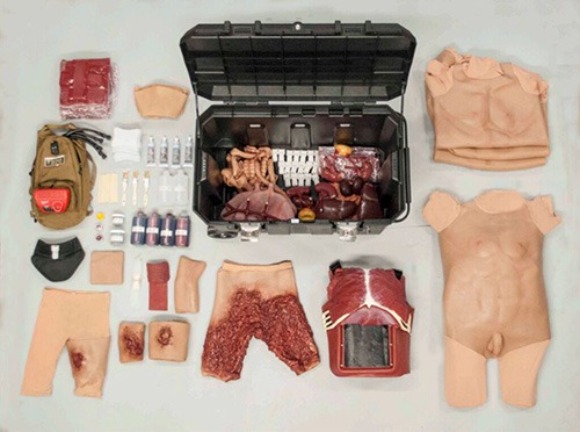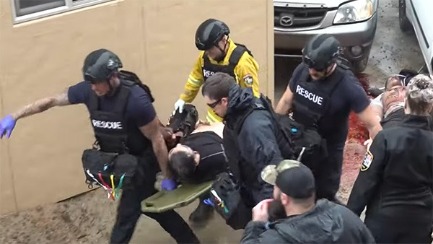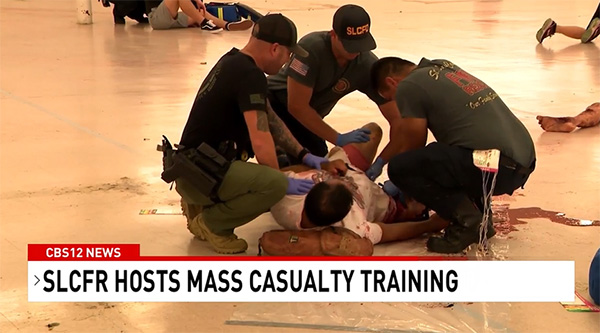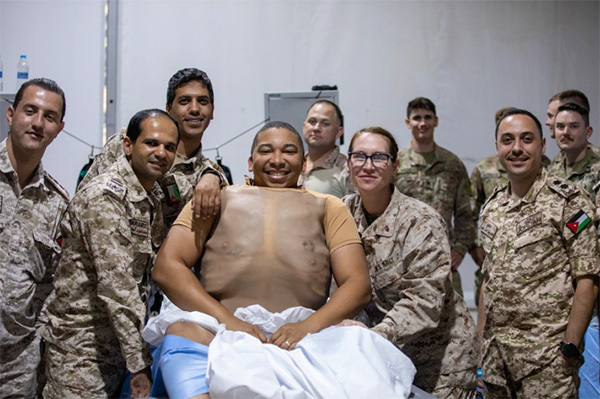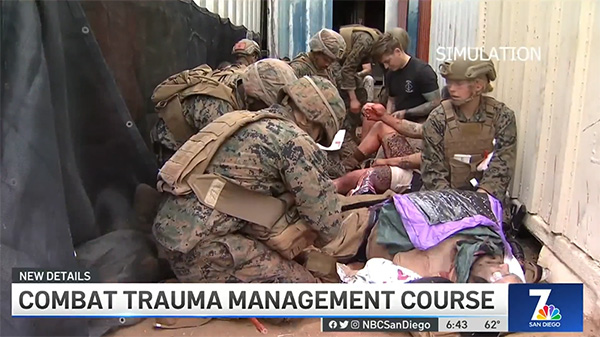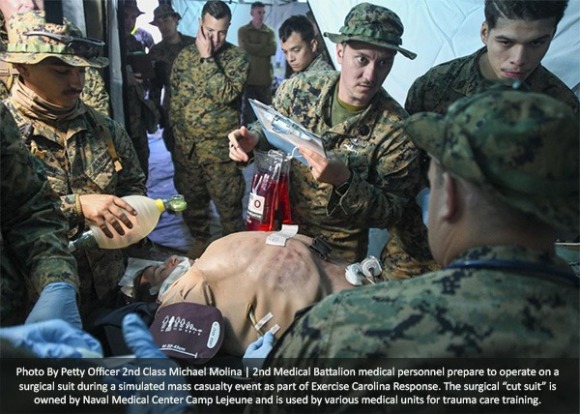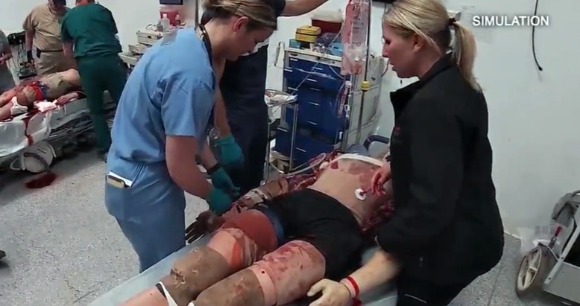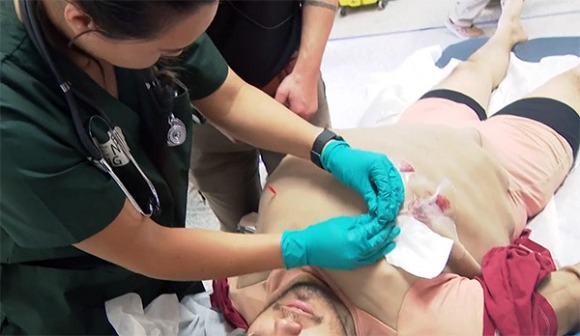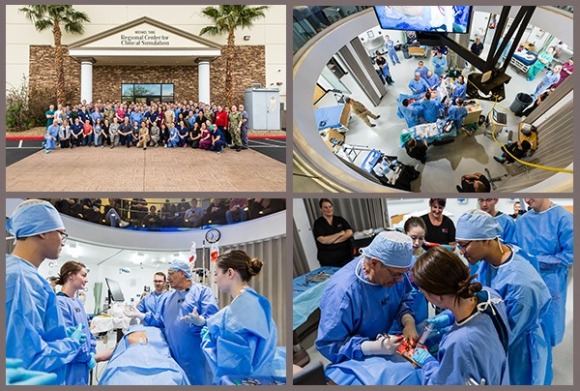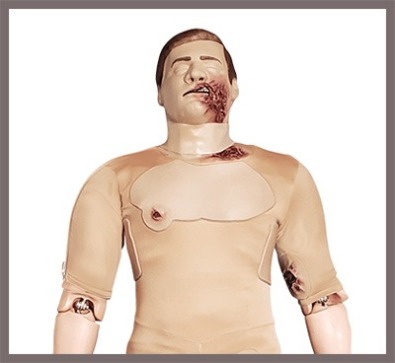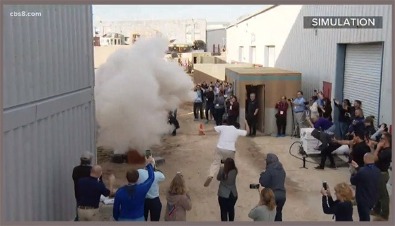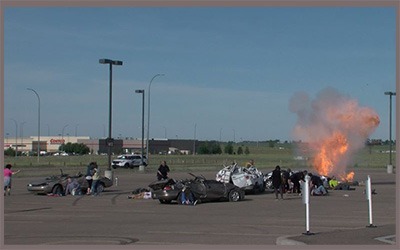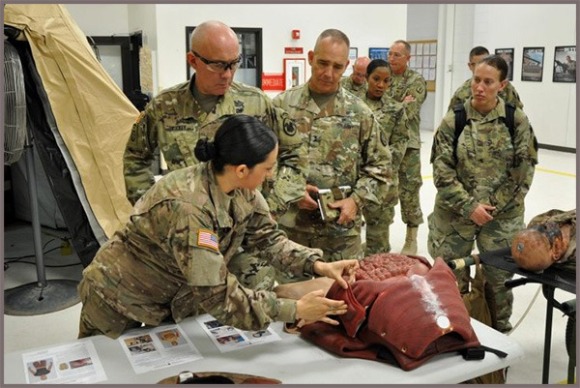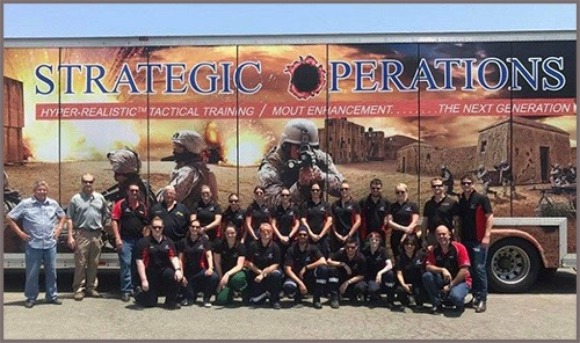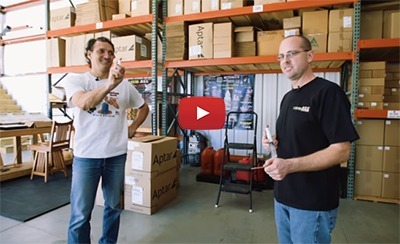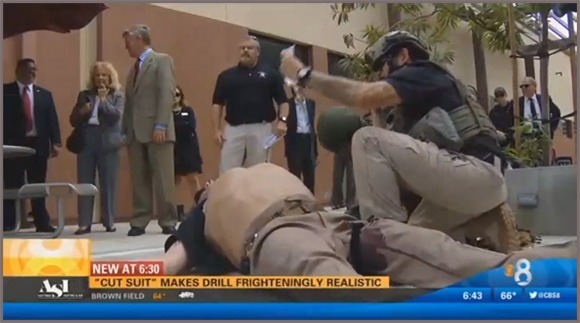|
Strategic Operations - News
2016 - 2024
A collection of news and press items featuring Strategic Operations, Inc.
First responders receive mass casualty simulation training
CBS8 San Diego
Posted January 20, 2024
SAN DIEGO, CA — A hyper simulated event took place Strategic Operations to train military, first responders and emergency healthcare professionals from all over the world for a mass casualty scenario. It also teaches them how to act quickly in a worst-case scenario. For Sheriff's deputies, training like this contributes to their preparedness for real-life situations.
Watch Now (YouTube)
‘Realistic’ training strengthens school safety
By Denis Grasska - The Southern Cross
Posted October 9, 2023
San Diego — Catholic school educators in San Diego underwent an intense four-day Diamond Safety Team Training, simulating crisis situations to equip them with practical threat-assessment strategies and develop comprehensive campus-safety plans. The training, initiated by the San Diego County Office of Education, included realistic scenarios involving active-shooter situations and bleeding control.
Read Now
Preparing for the unthinkable: St. Lucie first responders train for mass casualty events
By Alexis Cruz - CBS12
Posted July 18, 2023
PORT ST. LUCIE, Fla. — St. Lucie County first responders spent a week participating in extensive mass casualty training, preparing them for the unpredictable.
Watch Now
Podcast Interview - The Way I Heard It with Mike Rowe
Naked Volleyball and Other Strategic Operations with Stu Segall
Posted July 11, 2023
San Diego — The successful producer of hit shows like Hunter, Renegade, and Silk Stalkings talks about how 9/11 changed television forever and led him to turn his 20-acre studio into Strategic Operations, a training facility that has allowed hundreds of thousands of military, law enforcement, and first responder personnel to experience medical and tactical training in “Hyper-Realistic® scenario environments".
Listen Now
U.S. Navy Med and JAF Group Photo
Posted July 10, 2023
Jordan — U.S. Navy Lt. Cmdr. Sarah Secor-Jones, deputy force surgeon, U.S. Marine Corps Forces, Central Command, poses for a photo with Jordanian Armed Forces medical staff after practicing medical procedures during Intrepid Maven 23.4, July 10, 2023.
Intrepid Maven is a bilateral exercise between U.S. Marine Corps Forces, Central Command and the Jordanian Armed Forces designed to improve interoperability, strengthen partner-nation relationships in the U.S. Central Command area of responsibility, and improve both individual and bilateral unit readiness. Secor-Jones is a native of Glens Falls, NY. (U.S. Marine Corps Photo by Cpl. Jonah White)
The appearance of U.S. Department of Defense (DoD) visual information does not imply or constitute DoD endorsement.
Image Source
Simulation Helps Marines Practice Combat Trauma Management
Posted May 25, 2023
San Diego, CA — NBC 7 photojournalist Paul Makarushka received a first-hand look at how Marines operate in high-stress situations involving traumatic injuries.
Watch Video
‘Train as you fight’- Surgical suit brings realistic training to military operations
Author: Michelle Cornell
Posted December 13, 2022 (Story from 12.08.2022)
CAMP LEJEUNE , NC, UNITED STATES — With readiness of the medical force a top-priority, Naval Medical Center Camp Lejeune often collaborates with entities across Marine Corps Base Camp Lejeune to train for real-life medical emergencies. In October, 2nd Medical Battalion tapped NMCCL’s Staff Education and Training Team for use of the medical center’s Human Worn Partial Task Surgical Simulator, or “cut suit”.
The appearance of U.S. Department of Defense (DoD) visual information does not imply or constitute DoD endorsement.
Read Full Article
Video - Tactical Combat Casualty Care Training
November, 2022 - Featuring the culminating event of a three week long course where role players simulate a realistic environment a corpsman or provider could be expected to be experienced on a future deployment.
Strategic Operations Immersive Surgical and Trauma Skills Course week - KUSI News Coverage
May 2022 - Medical students experience Hyper-Realistic
® training, exposing them to traumatic scenarios using the techniques of filmmaking special effects and make-up. Coupled with the patented wearable medical simulation aides from Strategic Operations Medical, the scenarios offer stress-inoculation for medical professionals and first responders.
Medical students experience trauma training in San Diego
Author: Domenick Candelieri
Posted May 13, 2022 (FOX5 San Diego)
Read Article
At Strategic Operations, Inc. in Kearny Mesa, medical students from the West Coast had the extraordinary opportunity to engage in a unique and intensive surgical and trauma training. Throughout the week-long program, participants faced simulations involving active shooters, car crashes, and explosions. This hands-on experience provided them with invaluable skills and expertise in handling critical situations.
'It’s kind of nice to see how we handle the stress' | Mass casualty simulations in Kearny Mesa used to train medical students
Author: Brian White
Posted May 13, 2022 CBS8 May 13, 2022 Read Article
This week, Kearny Mesa is hosting a crucial training program for forty-two medical students hailing from various parts of the country. The students are immersed in simulated mass casualty scenarios, providing them with invaluable hands-on experience. The training is taking place at Strategic Operations, a facility once known as a TV and movie studio for Stu Segall Productions, as CBS 8 observed during their visit. By subjecting the students to hyper-realistic conditions, this program enables them to build resilience against stress, ultimately enhancing their performance when faced with real-life medical challenges.
Hyper-Realistic® Medical Training with Strategic Operations - Podcast
Posted September 3, 2021
Wyatt and Lindell stop by Gun Owners Radio Podcast to show off the latest medical training products and discuss Hyper-Realistic
® training at Strategic Operations in San Diego.
A Patient-Driven Simulation: A Look at the Cut Suit
Posted Apr 20, 2021
From virtual simulation to synthetic cadavers and more, surgical technology and surgical assisting programs are incorporating the very latest in innovative, hands-on training activities into their curricula. The Cut Suit is a simulation tool that is worn by a live human and replicates the look and feel of traumatic injuries.
[Image: Pictured is the Cut Suit and its multiple components. The suit is intended to be worn by live patient “actors” and helps simulate trauma events.]
Designed by surgeons for surgeons, the Cut Suit allows students to practice for high-pressure situations with room to safely make non-life threatening errors. Anthony LaPorta is the director of the Military Medicine Program at Rocky Vista University in Colorado, and has used the Cut Suit with students for the last 10 years. “We’ve trained hundreds of medical students using the technology, and the results are consistently astounding. The suits are very reusable [and] very versatile.” As a respected expert in the field of military medicine, LaPorta was involved in the development of the Cut Suit but does not have an economic stake in the resource.
LaPorta notes that Cut Suit training has led to dramatic improvements in students’ technical skills and their ability to identify surgical instruments. He relates his experience with Cut Suit training to his time as a military surgeon.
“This is how we train students in the military,” LaPorta says. “You have to let students make mistakes in real-time and learn from them. The Cut Suit offers the benefits of habituation training in a controlled setting.”
While the Military Medicine Program at Rocky Vista University largely works in training students to become physicians, this simulator also provides many benefits for surgical technology and surgical assisting students. The Cut Suit can be used in collaboration with other programs for trauma training, wherein EMS students stabilize the patient, nursing students triage the patients, radiology students prepare for imaging, and surgical technology and surgical assisting students prepare the operating room and assist with surgery.
The Cut Suit also helps to humanize the patient, ultimately allowing surgical technology and surgical assisting students to build soft skills around patient management. Because the suit is worn by a live human, students get a feel for treating a person rather than an inanimate object. The patient actor can express themselves freely — screaming, panicking or fighting — which makes for a realistic learning experience that students can’t ignore in the moment.
As it becomes more common to perform some surgeries without general anesthesia — for example, orthopedic procedures that use spinal anesthesia, C-sections where the patient is awake and some traumatic scenarios where patient is brought in awake — learning how to engage with and soothe a patient in high-stress environments early on will only empower surgical technologists and surgical assistants in their learning journey. The Cut Suit is just one option among many simulation tools that help students become increasingly familiar with their role in the operating room — and most importantly, care for the safety and well-being of the patient.
Anthony LaPorta, MD, FACS, is a professor of surgery and the director of the Military Science Program at Rocky Vista Mountain University in Parker, Colorado. LaPorta retired from the U.S. Army as a Colonel after over 26 years of service. He has authored more than 200 peer-reviewed articles and presentations on surgery, immunology, military medicine, and simulation. He originally trained in surgery at the Medical College of Wisconsin and the University of Oxford, England.
The Effect of Hyper-Realistic Trauma Training on Emotional Intelligence in Second Year Military Medical Students
Journal of Surgical Education - Volume 77, Issue 6, November–December 2020
Posted November 24, 2020
Erin West OMS3, Gail Singer-Chang PsyD, Rebecca Ryznar PhD, David Ross DO FACEP, Michael Czekajlo MD, Tuan Hoang MD, Roy Alson MD PhD, German Berbel DO, Alan Moloff DO MPH, Marian Safaoui MD, Natalie Nevins DO, Anthony J. LaPorta MD, FACS
Read Original Report
Strategic Habitats: La Jolla resident turns shipping containers into homes to help San Diego’s homeless
By Elisabeth Frausto - Staff Writer - La Jolla Light
Posted September 28, 2020
Read Article
The New SOF Medic Training Cell Will Finally Unite SEALs and Corpsmen
By Jonathan Weiss
Posted September 22, 2020 Read Article
A taste of Hollywood could help San Diego's homeless population
'Strategic Habitats' are using technology from movie sets and buildings to assist homeless crisis.
Author: Jeff Zevely (Reporter)
Posted August 25, 2020 (CBS8 News)
Read Article
Kearny Mesa company to use training tool for first responders to house homeless
By Mark Saunders
Posted August 10, 2020 (From San Diego ABC10) Read Article
Shipping containers pitched as next stop after Convention Center shelter
One housing unit could be built faster and cheaper than converting old motels or building new units
By Gary Warth
Posted August 6, 2020 (From The San Diego Union Tribune) Read Article
Strategic Operations Announces 'Strategic Habitats™' - Innovative, Affordable, Long-Term Solution for Temporary Housing for Homeless Families
Posted July 30, 2020
For more than 18 years, San Diego’s Strategic Operations, located on the backlot of the Stu Segall Productions television and movie studio, has been providing innovative, leading-edge products and services that have solved a myriad of problems encountered by our military, first responders and medical industry. The company is now committed to solving one of our nation’s biggest problems — housing our homeless population — with the introduction of “Strategic Habitats™”, an innovative, affordable, long-term solution for temporary housing for homeless families.
This premier educational event for the military medical professional offered both basic and advanced sessions for military physicians and students in any stage of their career.
On Saturday March 7, attendees traveled via bus to Touro University Nevada to observe various simulated surgical procedures performed inside the
Tang Regional Center for Clinical Simulation building. The Strategic Operations Cut Suit® was featured during a portion of this demonstration lead by the instructional expertise of Dr. Anthony Laporta, MD, FACS, Rocky Vista University.
AMOPS 2020 Annual Meeting & Medical Conference Wrap Up
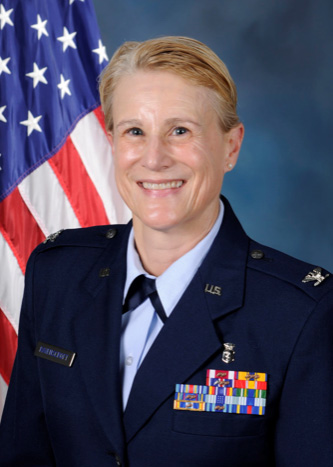
Col Jennifer L. Ravenscroft, DO, FACOFP
AMOPS Immediate Past President
As great as Thursday and Friday was, a wonderful treat was in store for AMOPS attendees on Saturday. AMOPS partnered with Touro University Nevada for an excellent simulation symposium. A special thank you to Shelley Berkley, CEO and Senior Provost for Touro’s Western Division; Ray Alden, PhD, Provost of Touro University Nevada; Wolfgang Gilliar, DO, Dean of the College of Osteopathic Medicine; and David Clegg, Administrative Director of Clinical Simulation for letting AMOPS use the Touro University Nevada Simulation Center.
David Clegg planned the simulation symposium which included an OB/GYN postpartum hemorrhage, femoral fracture with ortho fixation, emergency appendectomy, and a gunshot wound with emergency laparotomy scenarios. Mr. Clegg brought in Anthony J. LaPorta, MD, Col (Ret), USA, Professor of Surgery and Military Medicine at RVUCOM, and Tuan Hoang, MD, CAPT, USN, Command Senior Surgeon, Naval Medical Readiness Training Command, 29 Palms to lead the simulations. AMOPS attending physicians performed the simulation scenarios with the assistance of student members. Strategic Operations (Steve Markham) provided the cut suits and training crew (Gino Ortiz and Jethro) at no cost. Mock Medical Simulated Surgical Instruments (Dari Dingel-Fehr, CPhT, CST) provided the surgical instruments at no cost.
Read Newsletter (PDF)
Willow the dog is on the job, sniffing out Internet crimes against children
By KAREN KUCHER Posted February 21, 2020 (From The San Diego Union Tribune - 2/18/2020) The 2-year-old electronic scent detection dog has been on the job since November and already has been on a half dozen searches Read Article (Website Note: Strategic Operations also offers an environment for agencies in training detection dogs. Willow is just one of many dogs who have had the opportunity to hone their detection skills here at STOPS San Diego.)
Transforming Tactical Combat Casualty Care to Civilian Providers via Medical Simulation
Posted January 23, 2020 (From HealthySimulation.com January 9, 2020)
Read Article
A hyper-realistic active shooter and mass casualty simulation helps to prepare for the real event
Posted January 20, 2020
Dozens of first responders took place in a simulated active shooter and mass casualty event on Saturday in Kearny Mesa. Local firefighters, paramedics, and police participated in the event to teach educators and clinicians how to conduct similar scenarios for crisis training across the country. The training exercise was for attendees of the International Meeting on Simulation in Healthcare conference (IMSH 2020) taking place in San Diego. The San Diego conference included healthcare educators and clinicians from across the world.
The event took place on the backlot of the former Stu Segall Productions TV studio. The simulation included hyper-realistic explosions and actors portraying active shooters, bombers and point of injury casualties.
The event also included a new "Cut Suit®," a training suit that can be worn by people to simulate actual surgical procedures.
Watch Video
8th Annual Intensive Surgical and Trauma Skills Course (ISTSC)
Posted June 6, 2019
A unique emergency room in San Diego was inundated all week recently with trauma casualties and very sick people requiring surgery, and second year medical students performed surgeries. The trauma resulted from overturned cars, active shooters and improvised explosive devices. Real firefighters, paramedics, and police were the first responders at the scene.
All this occurred at Strategic Operations on the back lot of Stu Segall Productions TV/film studio and the ER and operating rooms are simulation labs constructed for a very unique – one of a kind in the nation – Intensive Surgical & Trauma Skills Course (ISTSC). Forty-two surgeries were performed on live humans – wearing Strategic Operations’ human-worn simulators called “
Cut Suits®,” the only hyper-realistic open surgical simulators in the world.
Read More about the 8th Annual Intensive Surgical and Trauma Skills Course (ISTSC)
Mass Casuality Exercise - Medicine Hat, Alberta, Canada
Posted June 6, 2019
(ST/OPS Canada
) conducted a Mass Causality exercise in partnership with the City of Medicine Hat, Alberta, Canada. These full scale emergency exercises prepare police, fire, and EMS to respond to a major crisis.
Chat News Today Canada reported on this unique and vital exercise.
Read More and Watch Video
Realistic Trauma Training Hones Surgical Teams
Posted December 18, 2018
With up-to-date intensive curriculum in an immersive environment, simulations can improve medical readiness and patient outcomes.
Read Article: Proceedings - December 2018 issue
Strategic Operations in the News - Simulated Attack Response - FOX 5 San Diego Coverage
Posted May 11, 2018
On 29 April through 4 May 2018 students from Rocky Vista University College of Osteopathic Medicine (RVUCOM) military medicine track will be joined by students from the Kansas City University of Medicine and Biosciences College of Osteopathic Medicine and the College of Osteopathic Medicine of the Pacific (COMP) at Western University of Health Sciences.
Intensive Surgical & Trauma Skills Week (ISTSC) at Strategic Operations May 1-4, 2018
Posted May 8, 2018 (From Medical Training Magazine May 1, 2018
A unique emergency room in San Diego, California will be inundated with trauma casualties and very sick people requiring surgery May 1-4, and second year medical students will be those performing surgeries. The simulated trauma scenarios will result from overturned cars, active shooters, a high-rise fire and improvised explosive devices. Real firefighters, paramedics and police will be the first responders at the scene.
Read More
The Seventh Annual Hyper-Realistic® Intensive Surgical & Trauma Skills Week (ISTSC) will be conducted at Strategic Operations April 29 to May 4, 2018
Posted April 26, 2018 (Press Release)
Second Year Medical Students Immersed in Week-Long Series of Life or Death Scenarios Involving Overturned Cars, Active Shooters and IEDs
SAN DIEGO — April 29, 2018 — A unique emergency room in San Diego will be inundated all week with trauma casualties and very sick people requiring surgery, and second year medical students will be those performing surgeries.
The trauma will result from overturned cars, active shooters, a high-rise fire, and improvised explosive devices. Real firefighters, paramedics, and police will be the first responders at the scene. All this will occur at Strategic Operations (STOPS) on the back lot of Stu Segall Productions TV/film studio and the ER and operating rooms are simulation labs constructed for a very unique – one of a kind in the nation – Intensive Surgical & Trauma Skills Course (ISTSC).
From 29 April to May 4, Rocky Vista University College of Osteopathic Medicine (RVUCOM) in Parker, Colorado, Kansas City University of Medicine and Biosciences (KCUMB) and the College of Osteopathic Medicine of the Pacific (COMP) at Western University of Health Sciences will conduct the ISTSC at STOPS’ Simulation Lab. Overhead catwalks and video camera systems enable live viewing and after action review. Forty-five live-action, Hyper-Realistic® simulations of both medical and surgical problems will be created, immersing the participants from point of injury all the way through the ER and OR.
Thirty-five surgeries will be performed on live humans – wearing Strategic Operations’ simulators called “
Cut Suits®.”
Thirty-six second-year medical students, many teaching faculty and visiting surgeons and physicians, as well as surgical and ER residents and staff from Balboa Naval Hospital and local hospitals will participate.
Rocky Vista University (RVU) is a health sciences university located in Parker, Colorado. RVU’s College of Osteopathic Medicine (RVUCOM) was founded in 2006 and opened its doors in August of 2008, enrolling students in its four year program of study leading to the Doctor of Osteopathic Medicine (D.O.) degree. The University is located in a 145,000-square-foot contemporary facility on twenty acres, housing the latest in classroom, lecture, laboratory and audiovisual equipment, with additional instruction conducted at numerous teaching hospitals throughout the state of Colorado. Rocky Vista University provides quality healthcare education while inspiring students to serve with compassion, integrity and excellence. For more information, visit www.rvu.edu or call 720-875-2804.
Kansas City University of Medicine and Biosciences graduates more physicians annually than any other medical school in Missouri. Active in the Kansas City medical community since 1916, KCUMB is one of the oldest and largest of the nation’s 29 colleges of osteopathic medicine. KCUMB is known as a leader in osteopathic medical education, with an educational environment that emphasizes both academic excellence and the education of caring physicians who place their patients’ needs above all else. For more information, visit http://www.kcumb.edu/about/ or call 816-654-7000.
The College of Osteopathic Medicine of the Pacific (COMP) was established in 1977 in Pomona, California as a direct and important response to a critical shortage of primary care physicians in the western United States. COMP remained as the only osteopathic medical school west of the Rocky Mountains for 18 years. In 1996, COMP was restructured into Western University of Health Sciences (WesternU), which is one of the largest graduate schools for the health professions in California. In 2011, WesternU expanded and opened COMP-Northwest in Lebanon, Oregon to provide medical education to the Pacific Northwest. After 40 years, they have graduated over 5,294 physicians with the majority choosing a career in primary care medicine. For more information, please visit www.westernu.edu or call (909)623-6116 for the Pomona campus or (541)259-0200 for the Lebanon campus.
About Strategic Operations
Strategic Operations Inc., on the lot of Stu Segall Productions, a full-service TV / movie studio in San Diego, Calif., provides “Hyper-Realistic®” training services and products for military, law enforcement and other organizations responsible for homeland security. The company employs state-of-the-art Hollywood battlefield special effects, combat wound effects, medical simulation systems like the “Cut Suit®,” role players, subject matter experts, and training scenarios to create training environments that are the most unique in the industry. Over the last 15 years Strategic Operations has provided Hyper-Realistic® training support to more than 850,000 military – and civilian first responders – in the U.S. and Canada. For more information, visit www.strategic-operations.com.
###
Advanced Surgical Skills Package (ASSP) to be on display at IMSH
Posted January 15, 2018 (Press Release)
Strategic Operations To Announce New Surgical Skills Product — The Advanced Surgical Skills Package (ASSP) at 2018 International Meeting on Simulation in Healthcare (IMSH) January 14-16 in Los Angeles
Surgeons Will Perform Surgery Using ASSP a Live Human Wearing a Surgical Simulator (‘Cut Suit’) at the Los Angeles Convention Center
LOS ANGELES – January 15, 2018 – Strategic Operations (STOPS) will announce an innovative new surgical simulation product — the
Advanced Surgical Skills Package (ASSP) — at the International Meeting on Simulation in Healthcare (IMSH) January 14-16 at the Los Angeles. Convention Center. IMSH is the most important healthcare simulation conference of the year.
The ASSP will drop into the STOPS human-worn simulator, known as the
Cut Suit, as a plug-and-play module to provide high fidelity anatomy for specific surgical procedures such as repair of damaged spleen, damaged liver, perforated small bowel or any other trauma or pathology requiring open surgery. Additional ASSPs will be introduced for other abdominal as well as thoracic surgical procedures.
CAE Healthcare is the global distributor of Strategic Operations medical products. At the CAE booth #300 at 12:45 PM on Monday January 15, a surgeon will perform a splenectomy using the ASSP.
STOPS developed the human-worn surgical simulator (Cut Suit) to provide hyper-realistic continuum of care training and education.
Since its introduction five years ago the Cut Suit has been an important advance in creating hyper-realistic, immersive simulations for medical training and education.
The ASSPs will be shipped to Cut Suit clients with pre-paid returnable cases, complete with instructions, DVDs, surgical blood and other accessories – on a daily rental basis. No need for the client to repair – only flush with water and ship back in the postage pre-paid container. ASSPs will be available in this spring.
# # #
Strategic Operations host American College of Surgeons Stop The Bleed Course
Posted October 19, 2017 (Press Release)
Contact: Kim A. Merrill
Merrill Marketing/Communications
(858) 547-1865
[email protected]
NEWS FOR IMMEDIATE RELEASE
Strategic Operations Hosts American College of Surgeons Stop the Bleed Course
Medical students will learn bleeding control techniques in a hyper-realistic active-shooter scenario at San Diego movie set.
SAN DIEGO (20 October 2017) — Members of the American College of Surgeons (ACS) and other qualified instructors will train 40 medical students in life-saving bleeding control techniques this Sunday October 22, from 7:30 to 10:30 AM during a training session, hosted by Strategic Operations on the lot of the former Stu Segall Productions TV/Movie studio. Under simulated circumstances, ACS surgeons will teach medical students to control serious bleeding with tourniquets and wound packing on live actors posing as seriously injured bystanders in a hyper-realistic active-shooter scenario with movie-style enhancements including gunfire, explosions, and medical special effects.
These simulated injuries on live humans will be treated at the point of injury and the patients next transported to a realistic emergency room, and then on to the operating room where mock operations will be performed on the Human Worn Surgical Simulator known as the “Cut Suit.”
The training session is part of the “Stop the Bleed®” initiative, which began in 2015 and puts forth Presidential Policy Directive 8 for national preparedness, which targets preparedness as a shared responsibility of the government, the private and nonprofit sectors, and individual citizens. Enhancing survivability from active shooter and other mass casualty events by turning bystanders into lifesavers is at the core of Stop the Bleed training. This initiative grew out of the a cross-disciplinary group of stakeholders called the Hartford Consensus convened by the American College of Surgeons after the Sandy Hook mass shooting tragedy, and is now being promoted nationally by the ACS Committee on Trauma and Department of Homeland Security. The Hartford Consensus advocates that “no one should die from uncontrolled bleeding.”
The 40 participants taking the training course are among a group of more than 300 medical students who are in San Diego this week to attend the American College of Surgeons annual Clinical Congress, which convenes at the San Diego Convention Center, October 22-26. The Clinical Congress is one of the largest educational meetings of surgeons in the world and is expected to draw at least 13,000 attendees, including surgeons, allied health professionals, and industry representatives.
# # #
Camp Dodge, Iowa - Cut Suit Use
Posted August 11, 2017
Camp Dodge, Iowa – Capt. Vanessa Lagrange, Medical Training OIC, shows the various prosthetics used during training in the medical treatment facility portion to with LTG Charles D. Luckey, Chief of Army Reserve and Commanding General, United States Army Reserve Command, while touring the Sustainment Training Center at Camp Dodge Joint Maneuver Training Center in Johnston, Iowa on July 19, 2017. (U.S. Air National Guard photo by Tech. Sgt. Michael McGhee/Released)
Team Australia EMS Students and JEMS Editorial Staff visit Strategic Operations in San Diego, California
By AJ Heightman, MPA, EMT PEditor in Chief, JEMS Posted August 11, 2017 (Original article: July 19, 2017)
This week the JEMS Editorial Staff spent time time with 19 paramedic students and EMS system supervisors from Australia and New Zealand who are in the United States on a cooperative tour with assistance from JEMS and other agencies to provide an extreme educational experience for their degree paramedic students.
Read Article
Great Big Story - "History Will Remember the Inventor of Liquid Ass"
Posted June 28, 2017
How did a prank product become part of military training technology? This is the story of the one and only "Liquid Ass". (With an appearance by Stu Segall of Strategic Operations.).
5th Annual Intensive Surgical Skills Course Week (1 May - 6 May) at STOPS
A Letter from an Attending Medical Student
Posted May 18, 2017
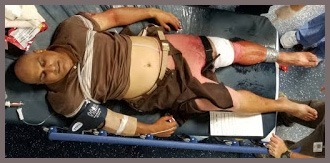
I would like to share with you my experiences in San Diego this past week. I was able to participate in “hyper-realistic” training for mass-casualty emergencies with 29 other medical students from two other schools. It was an experience that is difficult for me to put into words, and an attempt at fleshing out my thoughts is going to be a challenge. But hey, here’s to trying!
On day one, we were asked to write down what motivated us in medical school. And we were asked again on the last day. And I wrote down the following:
Day 1: “Success”
Day 6: “To save someone one day”
And that is a pretty accurate description of my week down in San Diego. I could stop here and leave it at that, but there’s so much depth to my training that I don’t want to short-change anyone and keep it for myself. Sure, I lost one week of “dedicated board prep” for our little adventure. But our experience was so much more than that. It was more of an existential journey, as cliche as that sounds, for my motivation in studying medicine. And to be honest, recently my motivation has been lacking, as one may tell with my simple half-hearted answer of “success” (which at the time, I thought was a pretty decent answer, because I wanted to prove myself — but that’s another story). So let me explain by putting you in my shoes for half of a day here.
Imagine for yourself, the following scenario:
You are the bright-eyed, bushy-tailed straight-out-of-medical-school Army physician who is relieving a colleague of a currently stable 45-year-old male patient who came in a few hours ago from a blast injury. Let’s face it — you haven’t experienced trauma before. The chaos around you is new to you, but it seems to have cooled down. The patient has two fractures: a left-humeral and left-femoral fracture. He lost 1L of blood which was replenished with 2U type-matched blood and 1L IV crystalloid fluids and was also given 2g Ceftriaxone IV. Xrays show complicated angular fractures of both extremities. He had a negative FAST exam and no head trauma. After the hand-off, you get to know the patient — his favorite movies, his recent trip to Baltimore — where hey! That’s where you’re from!… when all of a sudden he starts bleeding profusely from the loosened tourniquet on his lower leg and begins to have a massive seizure.
You are the physician.
Before you can think, two other colleagues rush to jump on the bleeding leg tourniquet, compressing it with their knees and yanking the tourniquet tight. The patient’s seizing and it’s your job to stop it. You can’t remember the drug to give the patient. You’re freaking out. From past experiences, the only real-life seizures you’ve seen were managed with waiting it out. So that’s all you can think of doing. But your patient doesn’t stop. He’s foaming at the mouth. He’s shaking all over and blood is all over your hands.
He’s in status epilepticus.
You don’t know what to do. You can’t remember how to help this patient. Even though you’ve been taught, over and over, about Ativan.
“Ativan!” someone shouts at you, “give that patient some fucking Ativan!!!!” and your body’s running for you towards the medication cabinet.. But it’s not anywhere. “How much Ativan are you going to give??”, and you realize you can’t remember the dose. Wait, were we even taught what the dose was? And then you remember. You’re not a physician. You’re a second year medical student, playing the role as a physician. You don’t know. You can’t even find the make-believe vial labeled Ativan. You weren’t required to know based off your curriculum. In panic, you ask your fellow doctors, AKA other second year medical students, who are now trying to escort out the worried-onlookers who rushed into your ER. No one can help you. And your patient is seizing, frying his brain right in front of you. And it’s your fault you don’t know. The REAL Navy physician supervising you has such a disappointed look on his face that reads: your lack of knowledge is killing this man.
Your mind is blank.
“If you don’t know what to do, look it up!! You have a phone!!” the Navy physician finally yells at you. So you stumble for your phone. In your nervousness, you can’t type right. You keep typing “atrivab doxage”, or “attivam dpsagr”, until finally you get it right. You find it: 0.5 mg to 2 mg IV. You rush to your patient to administer 1mg IV Ativan, and they finally stop seizing. You order more tests — FAST exam, chest XRAY, non-contrast head CT…
And you finally breathe again.
—-
This was the scenario I had on my last day at STOPS, and was by far the most motivating, and educational day for me there. “Success”? sure. But to me, I don’t care about proving myself anymore. One day I will be presented with a patient like him. In a real scenario, the knowledge I SHOULD have had may not come because of my lack of motivation to study all those years ago — which is right now. And that is why, my motivation for medical school has drastically changed. I am EXCITED to study for boards. The more I learn, the more deaths I can prevent from my own ignorance. There is no substitute in education for hands-on experience. That is what motivates you.
At least that’s what now motivates me.
And as a last note: now I will never, ever forget to now give a seizing trauma patient a dose of Ativan (which, I was told later, should have been 2mg because it was such an emergency, hehe). As I said on my Facebook post, I am so grateful for this week’s experience. I can’t wait to get out on rotations and apply this knowledge to actually help people, and “to save someone one day”.
Theresa Price, OMSII
2LT, US Army, MC
WesternU, COMP
Video Clip 1
Video Clip 2
Video Clip 3
NBC 7 News: Active Shooter Drill Trains Medical Students With Hyper Realistic Simulations in Kearny Mesa
By Cassia Pollock
Posted May 5, 2017
"This hyper-realistic hospital environment is intended to allow for the willing suspension of disbelief," stated Stu Segall, who previously worked in Hollywood as a TV producer.
Read Article
STOPS Cut Suit - Beaver Creek's Birds of Prey World Cup Downhill
Posted March 14, 2017
The Cut Suit is used for trauma response training on the slopes of Beaver Creek.
AllHands Magazine - More Sweat, Less Blood: Corpsmen Undergo Hyper-Realistic Training
Posted February 16, 2017 "The screams of the wounded echo throughout the combat zone. Blood from severed limbs oozes and gushes. Adrenaline pumps. These are just some of the horrors independent duty corpsmen (IDCs) encounter during their Navy careers. For now, it's training, but for students going through IDC "C" school at Surface Warfare Medical Institute Detachment (SWMI) San Diego, these scenarios will quickly become a reality, and they will have seconds to make life-saving decisions."
Grunt written by Mary Roach
Posted January 16, 2017
Grunt tackles the science behind some of a soldier's most challenging adversaries―panic, exhaustion, heat, noise―and introduces us to the scientists who seek to conquer them.
As detailed in one chapter, Mary visits Strategic Operations to observe a Hyper-Realistic
® training scenario where amputee actors help prepare Marine Corps medics for the shock and gore of combat wounds.
Available from
Amazon
Email Feedback: Realistic Training Better Prepares One for Stressful Environments
Posted January 15, 2017
(On January 12, 2017, Dr. LaPorta received an email from one of his students who went through ISSC two years ago and who graduates in May. 1st Lt Anthony Garzone USA will be going to Ft Gordon on active duty after graduation.)
From: Anthony Garzone
Sent: Thursday, January 12, 2017 12:57 PM
To: Dr. Anthony LaPorta
Subject: trauma
Dr. LaPorta,
I hope this email finds you well. I just wanted to let you know about an experience I had this morning. I was on my way to work in the Springs when I witnessed a car hit 5 small children. One girl was trapped under the back wheel. Myself and several guys lifted the car off her and I went to work. I took charge instinctively and immediately started my primary survey.
The whole time I could hear your voice along with everyone else’s voice from
cut suit week yelling in my head to “Do they have an airway?! Make them breathe!” etc etc.
I felt comfortable and calm during the event and with help from a stranger I was able to do a full primary and secondary survey. As well as, give a good coherent sign off to both the 911 dispatch as well as the EMTs once they arrived.
I must admit, I do not think I would have been as calm or confident (or even knew what the hell I was doing for that matter) without the basic training we got in San Diego.
With that, I wanted to say thank you for your hard work and what you and the rest of the guys do at cut suit week for us students. I did not realize the true value of it until today.
Anthony Garzone
Los Angeles Business Journal - Firm Offers Cut Suits as Real Plus to Medical Training
Posted December 31, 2016
While the Cut Suit has conventionally served as a practice tool for the military, law enforcement, and first responders, a growing trend sees an increasing number of medical schools and hospitals acquiring this advanced technology for hands-on training. Cedars, in particular, adopted the use of these suits a few months ago, making a significant investment in this innovative technology. Read Article
Strategic Operations Supporting the International Special Operations Forces Week
Posted May 31, 2016
On May 25th, 2016 U.S. and International SOF conducted a combined, tactical, scenario-driven demonstration as part of International Special Operations Forces Week and the Special Operations Forces Industrial Conference (SOFIC).
The San Diego Union Tribune - ‘Cut suits’ Give a Slice of Realism to Training
By Gary Warth
Posted May 25, 2016
'Cut suits' from Strategic Operations, Inc., are demonstrated at Palomar College.
Read Article
"Cut Suit" Makes Drill Frighteningly Realistic
Posted May 25, 2016
Mannequins are often used for training in disaster preparedness drills, but Palomar College has acquired an advanced piece of equipment that creates an extremely realistic simulation of great bodily injuries. CBS News 8’s Shawn Styles has the details in this video report.
Watch the video on CBS8 Website
CBS8 Report - Strategic Operations Hosts Active Shooter Drills
Posted May 10, 2016 Last week, a group of medical students, ER residents, and staff from Balboa Naval Hospital and UC San Diego Medical Center engaged in a series of intense life-or-death scenarios. These simulations encompassed situations such as active shooters, overturned cars, and IEDs, providing the participants with valuable hands-on experience in handling critical emergencies.
Journal of Emergency Medical Services - Time is Blood
Posted April 11, 2016 (April 2016 Issue)
In the April 2016 issue of the Journal of Emergency Medical Services, A.J. Heightman, MPS, EMT-P, shares his knowledge and experience with training civilian emergency responders to save lives.
Read Article
IMSH Daily - Hyper-Realistic Saturday Workshop
Posted January 19, 2016
The International Meeting on Simulation in Healthcare (IMSH) is a scientific conference that explores the latest innovations and best practices in healthcare simulation. IMSH provides the tools and resources healthcare professionals need to advance their skills, impact change in delivery systems and practice, and, ultimately, to improve patient safety.
Strategic Operations was featured in the Monday, January 18, 2016 Edition of IMSH Daily (PDF opens in separate tab)
|
